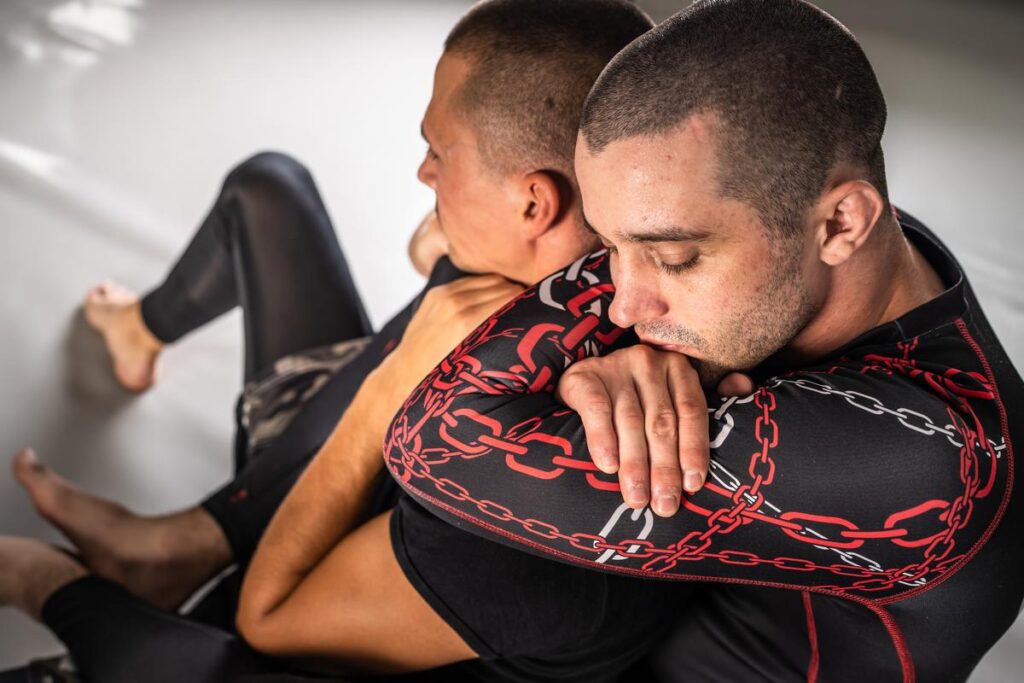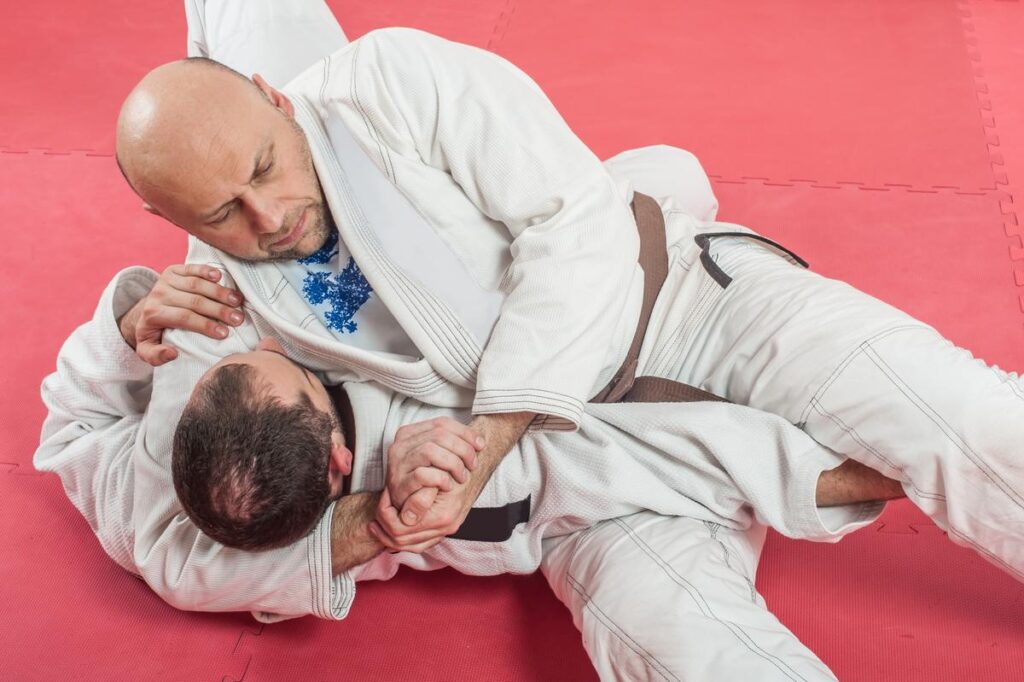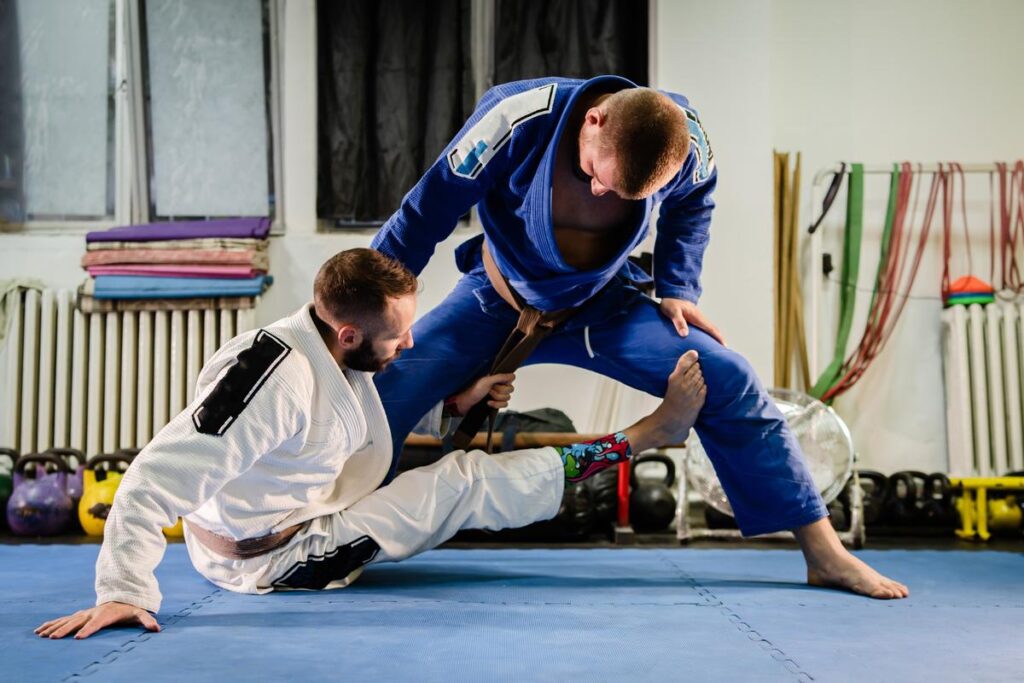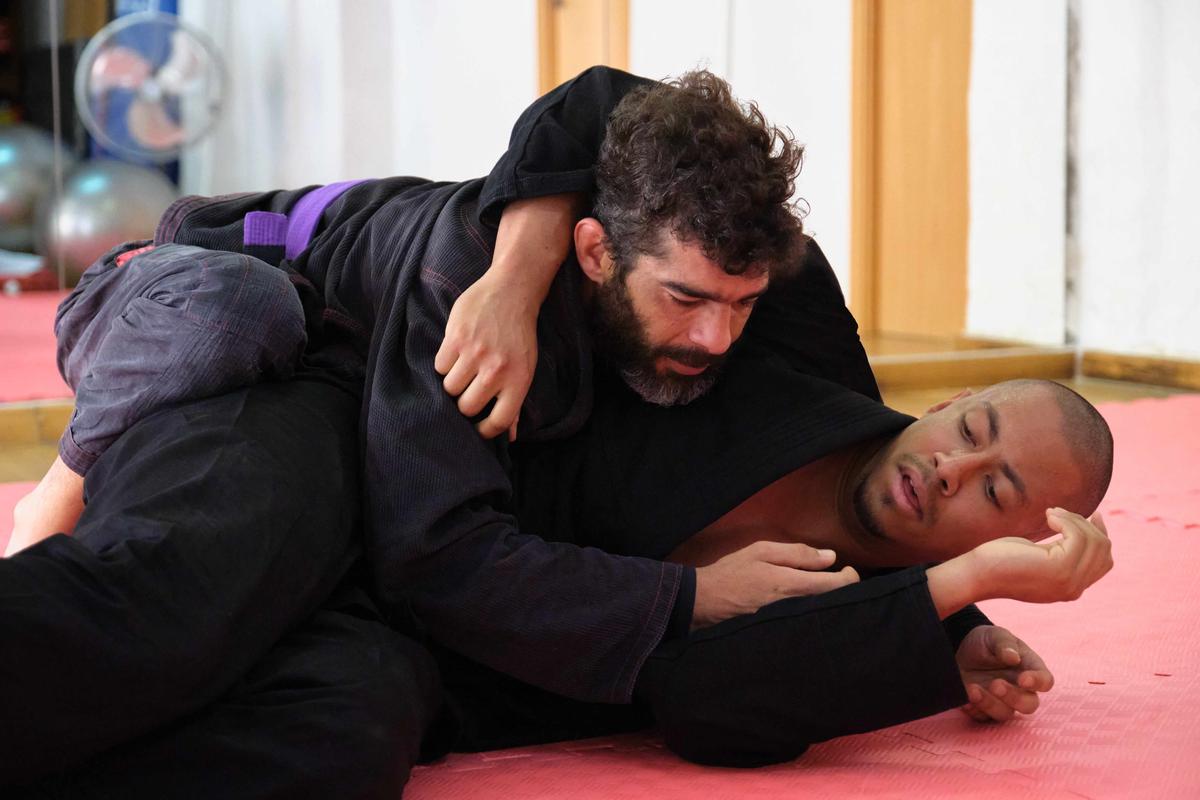In Brazilian Jiu-Jitsu, the half guard position refers to having one of your opponent’s legs trapped between your own legs while they are on top trying to pass your guard. This article will tell you “How To Improve Half Guard Game BJJ“
It is an important position that every BJJ practitioner needs to become proficient at for both gi and no-gi grappling.
Developing an effective half guard game takes time, but learning the right techniques and concepts can help accelerate your progress. This article provides a systematic approach on how to improve your half guard game in BJJ.
Having a good half guard enables you to stop your opponent from easily passing to side control or mount while creating opportunities for you to sweep, submit or escape back to a better guard position.
However, it requires you to have excellent framing, hip mobility and a variety of sweeps and attacks at your disposal. If your half guard foundation is weak, opponents will be able to smash through your defenses and shut down your offense.
We will break down fundamental concepts like proper knee and elbow positioning, hip shrimping, grip fighting tactics and regaining half guard if you get flattened out. Building this base will already make your half guard significantly harder to pass.
Next, we dive into high percentage sweeps from half guard like the old school sweep, hip bump sweep and knee push sweep.
Chaining these together creates constant sweep threats. We’ll also cover essential submissions you can attack with like the kimura and guillotine when opponents make mistakes.
Finally, we examine transitional techniques to move from half guard to more dominant positions like the back, X-guard, single leg takedown or full guard recovery.
Putting it all together gives you a well-rounded system to develop every aspect of your half guard game.
With the step-by-step tips in this guide “How To Improve Half Guard Game BJJ“, any BJJ student can elevate their half guard from a purely defensive position into a potent launching pad for attacks. Let’s begin improving your half guard!
There are a lot of question like Are Wrist Locks Legal in BJJ? and Can White Belts Do Wrist Lock BJJ and How much water should I drink during BJJ? people ask these question a lot of time so we covered all your questions.
Basic Half Guard Maintenance

The foundation of any effective half guard game is being able to maintain the position and prevent your opponent from smashing through you or passing to a more dominant position like side control or mount. Here are some key concepts and techniques for basic half guard maintenance:
Use Proper Framing
Framing with your arms and legs is crucial to create space, wedge yourself open and avoid getting crushed in half guard.
Frame against your opponent’s hips, knees, biceps or shoulders. Keep your arms stiff and elbows tucked.
Plant your top side foot on the mat to frame if getting flattened. Elevate your bottom knee to frame against their hip.
Shrimp and hip escape constantly to re-frame if angles are being smushed. Keep moving and readjusting.
Prevent Flattening Out
Do not allow yourself to get flattened out and pinned on your back. Stay up on your side.
Keep your bottom shoulder and knee glued together. shrimping your hips towards them if getting flattened.
Bump your opponent and elevate your hips to regain angle if they lean into you. Don’t be passive.
Rotate back to belly down if completely flattened out. Frame on the shoulder and hip to regain half guard.
Control the Far Arm
Grip fighting for inside control of their far arm/sleeve prevents getting passed and sets up attacks.
If losing control, swim for underhooks to regain leverage on the arm and disrupt their balance.
Keep their posting arm from landing on the mat – this stops downward pressure.
Regain Lost Half Guard
If your leg gets pushed down or they start to step over for the pass, stay patient.
Quickly bring your knees together and shrimp away to rotate back in and re-pummel for half guard.
For more distance, frame on their knee as you technical stand up to re-penetrate for half guard.
Spin under if completely passed to reverse position back into half guard.
Half Guard Sweeps on “How To Improve Half Guard Game BJJ”
Once you have solid half guard maintenance and retention skills, the next step is learning go-to sweeps that allow you to reverse positions and come on top.
Here are some high percentage sweeps to incorporate into your half guard game:

Hip Bump Sweep
The hip bump sweep is a fundamental BJJ sweep from half guard. Get an underhook on the far arm and cup the near side knee. Bridge your hips up into your opponent while pulling the underhook down and lifting the cupped knee.
Time this with their balance being forward. As they tip over the pivoting knee, finish in mount.
This basic sweep chains well with the knee shield half guard. Drill it repetitively until it becomes second nature. Modify the underhook to a strong overhook or wrist control as needed.
Old School Sweep
The old school sweep uses your bottom leg to catch their post and sweep them up and over. Trap their foot in your instep, hip escape and frame to lift them up.
Your leg acts as the pivot point to sweep them sideways and transition to side control or north-south as they go over.
This is a high percentage sweep in gi and no-gi. Maintain control of the trapped leg throughout the sweep motion. Time it as they transition feet and lose balance.
Deep Half Guard Roll Under Sweep
From deep half guard, control their far ankle or pant leg. Open your guard towards their trapped leg and roll under, lifting them up with your leg. Their momentum carries them over allowing you to come on top in side control.
Roll under deeply and accelerate quickly. Keep your head and arm tucked. Time this counter as they attempt to smash through your deep half guard.
Scissor Sweep from Half Guard
When opponent is standing or kneeling, a scissor sweep can catch them by surprise. Hug their leg tightly with your bottom leg. Kick the top leg up and out at 45 degrees while pulling them down with your arms to knock them back.
Use this half guard sweep when they leave one leg exposed focusing on passing your guard. Combine with an arm drag for more leverage.
Knee Push Sweep from Butterfly Half
From butterfly half guard, get double underhooks. Bring your top knee in front of their knee. Push back powerfully with this knee as you pull with the underhooks to knock them over the other knee and complete the sweep.
This adds an important sweep against opponents pressuring forward. It also transitions smoothly to X-guard. Time it as they drop weight forward.
Half Guard Submissions
While sweeps should be your priority from half guard, submissions can present themselves when your opponent makes a mistake or overcommits. Here are some high percentage submissions to attack with from the half guard:
Kimura Trap System from Butterfly Half Guard
The Kimura trap system utilizes the Kimura grip to set up sweeps and submissions from butterfly half guard. Control their wrist and grab reverse figure four grip. Use this to elevate and sweep them. If they defend, you can finish the Kimura or transition to the back.
This grip gives you tremendous control and attacking options. Drill entries from butterfly half guard and redirecting their arm when they defend.
Straight Armlock by Isolating the Arm
When you isolate an arm in half guard, going for the straight armlock is an effective submission finish. Trap their arm under your leg and secure a figure four grip on the wrist and elbow. Extend the arm while keeping elbow tight and lifting the hips up to finish.
Maintain shoulder pressure and use your leg to keep their arm contained. Best applied when they reach over-aggressively.
Brabo Choke from the Bottom
The Brabo or D’arce choke can sometimes be applied from half guard when your opponent leaves their neck exposed while passing. Wrap one arm around their head and under their armpit. Lock your hands and extend your torso back to finish the choke at an angle.
Time this choke as they flatten you out and overcommit forward. The angle and body lock is crucial to finish against their base.
Guillotine Choke
When an opponent postures up too high in your half guard, the guillotine choke can present itself. Shoot both arms up to lock around their neck. Lift your hips up at an angle while squeezing your elbows together to finish.
This capitalizes on their posture mistake. Keep your hips active and squeeze tight with the guillotine. Tuck your head to one side.
The kimura and guillotine in particular chain together with sweeps nicely, allowing you to attack both. Submissions force opponents to be cautious in half guard, creating openings for your sweeps and escapes.
Transitions to Other Guards/Positions

While half guard itself is an important position, you also need to develop smooth transitions to other guards and dominant positions from it. Here are key transitions to drill:
Recovering Full Guard
If you get flattened out in half guard, recovering full guard re-establishes your defensive layers. Face their trapped leg, bring your knees together and shrimp your hips away to free your leg and regain full guard.
You can also push off their hip and frame to make space to bring your leg out if flattened. Just don’t stay stuck in a smashed half guard.
Taking the Back
One of the most dominant transitions from half guard is taking your opponent’s back. Underhook the far arm, connect your hands and hip escape to spin out and take the back if they turn away.
You can also use your bottom leg to hook behind their far knee and lift it across your body while taking the back. This leg entanglement creates huge momentum to roll them over.
Moving to X-Guard and Single Leg X
X-guard provides more disruptive attacks from your back. To get there from half guard, push their knee down, extract your leg and swivel your hips back quickly while controlling their ankle. This also transitions to Single Leg X.
Use X-guard sweeps to scramble into top position. Or look to stand up and pass from there. Always control the ankle throughout entries.
Transitioning to Deep Half Guard
If getting flattened out, quickly swiveling down to deep half guard can save you. Secure their ankle and roll under or spin behind their leg to re-establish guard depth and control.
Use your head and frames to wedge yourself back into position. Deep half sweeps and leg entries reverse the momentum.
Coming Up on a Single Leg
When your opponent is driving hard to pass your half guard, you can bump them back and sit up for a single leg takedown. Control the ankle, hip out and come up grabbing behind their knee or hamstring to finish the single leg shot.
This turns the tables by putting you on the offensive. Change levels fast for maximum lift on the single leg.
Rounding out your half guard game requires learning not just attacks from the position itself but also how to transition to better guards or more dominant positions. Drill entries until they become second nature.
Drilling and Sparring Considerations
Having a dangerous and dynamic half guard can give you a key advantage when fighting skilled opponents.
But improving your half guard requires drilling the right techniques and sparring strategically to engrain the skills. Let’s look at some high-impact ways to use drilling and sparring to elevate your half guard game.
Drilling Considerations
Drilling is where you ingrain the techniques that will compose your half guard game. The following types of drills are essential:
Emphasize Control and Frames
The foundation of half guard is maintaining strong frames and connection points to control your opponent’s movements.
Drill creating “pillars” with your arms by framing across the hips or overhooking the shoulder. Practice wedging your top knee tightly to disrupt posture. Work hand fighting skills to own the underhook. Mastering control is the base for attacking.
Drill Hip Movement Patterns
Use repetitive hip bumping, bridging, and pummeling drills to develop the hip dynamism needed to generate power from half guard. Practice both lifting and off-balancing your opponent by driving your hips upward or sideways into them with different angles and timing. Smooth hip activation is vital to threatening sweeps or regaining guard.
Rep Footwork for Guard Retention
Footwork is integral but overlooked for retaining half guard against strong passers. Drill scooting backward then forward again quickly to re-establish position.
Work coordinating hip movement with steps to walk opponents into your control. Smooth foot patterns keep opponents from smashing through your guard.
Live Drilling with Varied Resistance
Once individual techniques feel sharper, do live drilling with partners offering increasing resistance. This teaches adapting motions against realistic energy and reactions.
Start at 50% resistance, then increase force applied over time. You want your go-to half guard techniques to feel crisp against fully uncooperative opponents.
Sparring Considerations
Strategic sparring sessions are where you pressure test new half guard skills. Here are effective ways to structure rounds:
Use Half Guard Only Sparring
Dedicate rounds to only playing from half guard regardless of what your partner does. This conditions you to constantly work back to your half guard. Only attacking and sweeping from here reinforces the imprinting. Limiting options builds specific focus.
Identify Weak Points
Note vulnerabilities like unstable framing, weak underhooks or getting flattened too easily. Then use time restricted rounds to isolate correcting those weaknesses through mindful repetition. Sparring reveals what needs work – drill those areas intently.
Counter Your Own Habits
Have a partner intentionally shut down your A-game sweeps and subs from half guard and force you to find alternatives. This builds flexibility beyond relying just on favorite techniques. Expand your half guard toolbox with计划 new attacks.
Double Attack Round
Agree to only attack with a sweep or submission once you’ve achieved a superior position like mount or back take. This incentivizes aggressively hunting submissions from half guard rather than stalling. Increase urgency.
Review Video Footage
Filming sparring rounds lets you study video to see where opponents are defeating your half guard. Note any adjustments needed, then drill to iron out those weaknesses. Video doesn’t lie!
The key is using live training for focused improvement. Avoid autopilot mode. Always spar with defined goals centered on developing new half guard skills. This builds precision.
Sample Training Split
Here is an example training split to improve half guard skills:
| Monday | Drilling and Sparring Focused on Half Guard |
| Tuesday | Upper Body Strengthening and Conditioning |
| Wednesday | Drilling and Sparring Focused on Passing Guard |
| Thursday | Lower Body and Core Strengthening |
| Friday | Light Drilling and Flow Rolling |
| Saturday | Rest and Recovery |
| Sunday | Rest and Recovery |
The split allows for two days per week of specialized half guard training while developing full body strength and preventing burnout. Listen to your body and adjust recovery needs accordingly.
Final Tips
Here are some final tips for How To Improve Half Guard Game BJJ:
- Fix holes instead of accumulating techniques
- Isolate positions in sparring like Bottom Half Guard Only rounds
- Combine new techniques together into sequences
- Make one adjustment at a time and drill it extensively
- Film rounds to identify vulnerabilities
- Spar half guard against bigger/stronger partners
- Know three attacks from every position within half guard
With intentional drilling and reflective sparring, your half guard game will reach new heights. Now get out there, train hard, and start dominating from half guard! Oss!
Wrapping Up On “How To Improve Half Guard Game BJJ”
Developing an dangerous half guard game in Brazilian Jiu-Jitsu requires diligently drilling key control techniques, strategically sparring to isolate weaknesses, and structuring overall training plans to drive continuous improvement. While challenging, putting in the work will pay major dividends for any grappler’s skills.
To build a strong half guard, dedicate time specifically to drilling essential techniques like establishing strong frames, disrupting your opponent’s posture, controlling grips and underhooks, and activating smooth hip motion to drive power. Repetition breeds competence. Make sure to drill control first before attacking.
Strategic sparring is then crucial to pressure test skills against fully resisting opponents. Use focused rounds like Half Guard Only rolling to provide concentrated refinement.
Analyze video footage to identify vulnerabilities, then emphasize correcting those weaknesses through drilling. Spar deliberately, not mindlessly.
A training plan that balances focused half guard work with complementary strength training provides the right recipe to level up. Strengthen your body to support new technique execution. Allow proper rest for recovery and retention.
Here are some key techniques to ingrain within a complete half guard game:
- Strong knee shield frame to control distance and disrupt forward pressure
- Overhook on the far shoulder to angle opponents and set up attacks
- Nearside underhook to prevent smashing and access back takes
- Quick hip bumps and bridges to unbalance opponents
- Coordinated scooting backward and forward to re-establish control
- Offensive threats like deep half guard sweeps, old school sweeps, Plan B, and more
Being highly effective from half guard provides tremendous strategic advantages in grappling. You can attack while retaining a safe position. This enhances competitiveness and expands tactical options against any style of opponent.
Other benefits of excelling from the half guard include:
- Frustrating and slowing down explosive passers
- Opening up submissions by threatening with sweeps
- Ability to attack from a position most would just play defensively
- Forcing opponents to constantly address your half guard game
- Saving energy compared to more intense full guard fighting
Make your half guard a cornerstone of your BJJ game. Force opponents to play your fight.
Of course, tailor your half guard approach to best suit your physical attributes and style. A flexible lightweight may prefer deep half variations, while a stocky heavyweight could control from top half guard or dogfight variations. Play to your strengths.
By combining an efficient half guard system, strategic training, and world-class coaching, you can gain a major edge over the competition. A razor-sharp half guard pays dividends across a grappling career. Your technique and results will elevate.
I hope now you got all the enough knowledge on “How To Improve Half Guard Game BJJ”

2 thoughts on “How To Improve Half Guard Game BJJ”
Comments are closed.